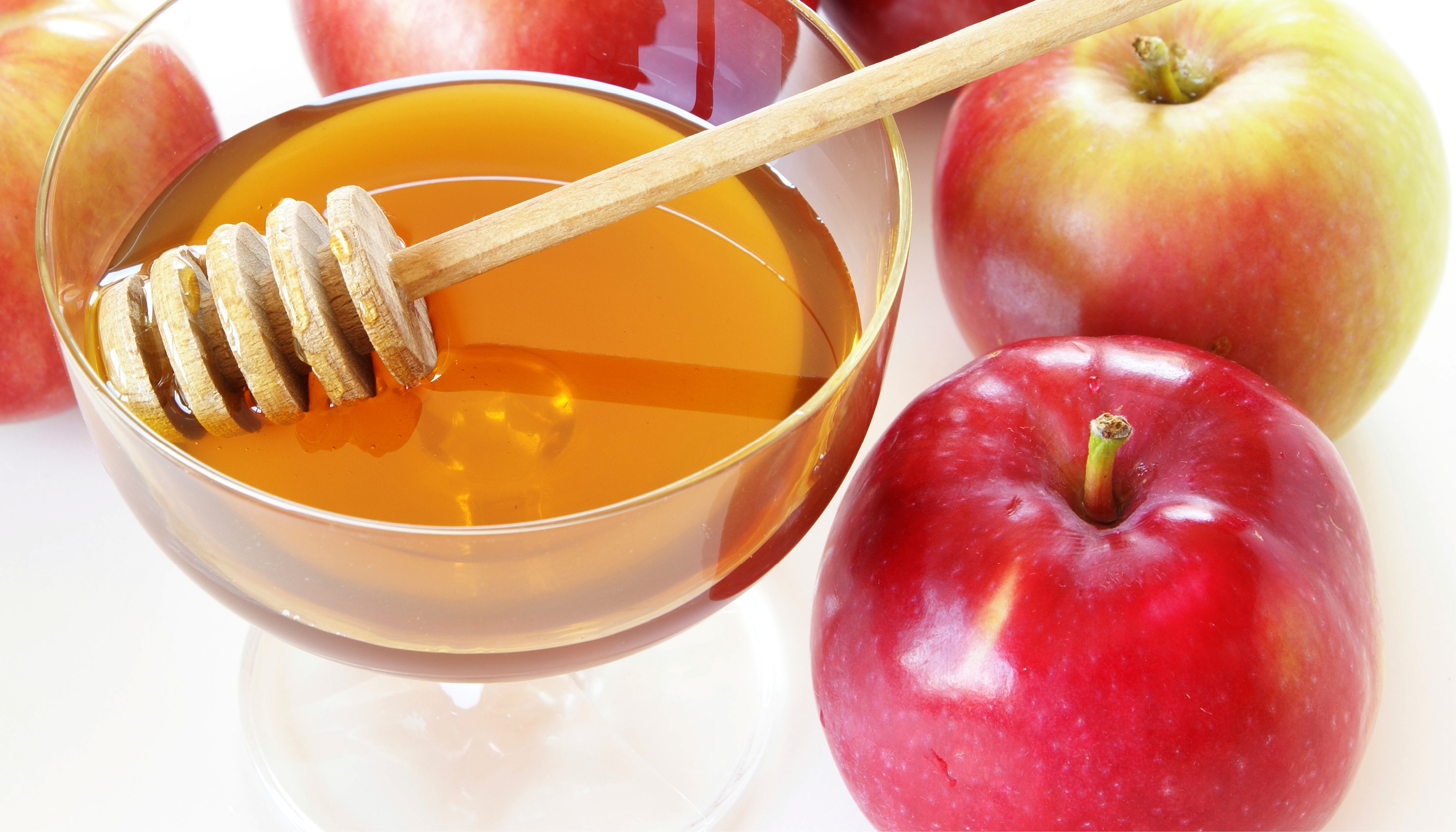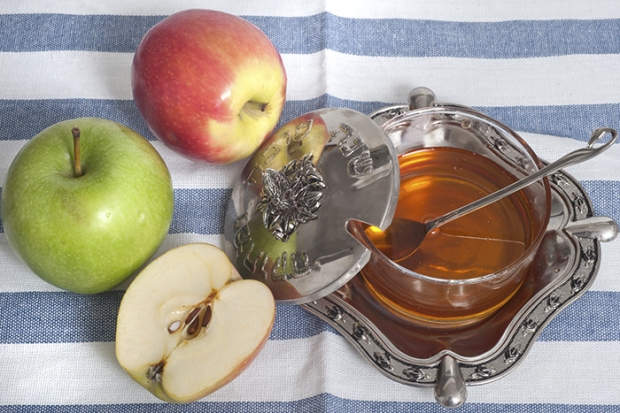
There are many wonderful customs, symbols, and traditions associated with Rosh HaShanah, the Jewish New Year, a time of prayer, self-reflection and repentance.
1. Preparing during the Hebrew month of Elul
Preparation for both Rosh HaShanah and (the “Day of Atonement”) customarily begins a full month before the holidays themselves, with the entire Hebrew month of dedicated to reflecting on the past year, and preparing to improving ourselves, our communities, and our world in the coming year. Learn more about how you can observe the month of Elul.
2. Celebrating at home
Jewish holidays begin in the evening, so many Jews begin Rosh HaShanah with a festive dinner with family or friends before attending services at a synagogue that night and again the following day.
On Erev Rosh HaShanah (the night the holiday begins), we recite the festival candle blessing and Kiddush (blessing over wine). We also recite HaMotzi (the blessing over bread) as usual, but the challah – the special twisted loaf Jews eat on Shabbat and other special occasions – is round, rather than the oblong loaf we eat during the rest of the year.
This custom has several explanations: One is that the round shape reflects the ongoing cycle of years and seasons; another is that, as our thoughts turn to repentance and self-improvement, the round reminds us that the opportunity for is always available. Another common interpretation is that the round challah resembles a crown, symbolizing the sovereignty of God – a common theme throughout the High Holidays. Learn how to make a round challah.
Throughout the centuries, Jews have commonly eaten apples – as well as challah, grapes, and other fruits – dipped in honey, which symbolizes the hope for sweetness and blessings in the year ahead. Learn more about the history of this Ashkenazi tradition. Some families also enjoy a pomegranate as a treat before the meal because, according to legend, the number of seeds in the pomegranate reflects the number of good deeds you will do in the coming year.
3. Celebrating in the synagogue
refers to the special penitential prayers Jews recite throughout the High Holiday season. Depending on the Hebrew calendar, Reform congregations generally observe Selichot in the hours before midnight on the Saturday night a week or two prior to Rosh HaShanah. The service, often conducted by candlelight, is a solemn preparation for the upcoming 10 days of reflection and self-examination. Learn more about Selichot and preparing for the High Holidays.
We learn from the (Leviticus 23:24-25) that Rosh HaShanah should be observed on the first day of the Hebrew month of . Many Jews take off from work and school to attend services, and all the seats in the sanctuary are often filled. Adjacent spaces, such as a social hall or auditorium, also may be filled. If a congregation’s sanctuary isn’t large enough for all its members, High Holiday services may be held in a different location, such as a college auditorium, hotel, or even a larger congregation whose services are also relocated elsewhere for the Days of Awe.
In recent years, a growing number of Reform congregations have adopted the practice of observing a second day of Rosh HaShanah. Conservative and Orthodox Jews in North America customarily observe two days of Rosh HaShanah, as do Jews in Israel where stores, schools, and businesses close for the holiday.
Whether you observe one or two days of Rosh HaShanah, the holiday is known for the grand style of its prayers and rituals, including blowing the in the synagogue. The liturgy places special emphasis on prayers that highlight God’s sovereignty and judgment along with our hope for God’s forgiveness. We repeatedly recite the penitential prayer Avinu Malkeinu on Rosh HaShanah and throughout the High Holiday season. It is customary to extend wishes for a good year to friends and family. In Hebrew, the simple form of the greeting is “!”
4. Reading the Torah
Torah selections for Rosh HaShanah include Genesis 21, which tells of the birth of Isaac, and Genesis 22:1-19, the story of the , or “The Binding of Isaac.” In those Reform congregations which observe a second day of Rosh HaShanah, an alternate Torah reading, Genesis 1:1-2:3, the story of the creation of the world, is often read on the second day of the holiday. The Reform offers an additional alternate Torah selection, Genesis 18:16-33, the story of Abraham’s arguing with God for justice of the innocent. The haftarah reading is from I Samuel and tells the story of Hannah. Alternate readings include Isaiah 55:6-13, which urges us to “seek the Eternal” and promises peace and joy, and Nehemiah 8:1-10, which tells the story of the public Torah reading on Rosh HaShanah in the time of Ezra and Nehemiah.
5. Blowing the shofar
Made from a ram’s horn, the is one of the world’s oldest wind instruments and has long played an important role as a ritual object in Jewish life. Its curved, bent shape symbolizes our humility as we stand before God to assess and consider our actions and behaviors during the past year.
The shofar is sounded throughout the Days of Awe, beginning during the month of Elul as a reminder of the upcoming High Holidays, and ending when its blast marks the conclusion of the final service on Yom Kippur.
The most common explanation for blowing the shofar during the Rosh HaShanah service derives from the story of the in Genesis 22, which we read on the holiday. According to the biblical story, Abraham substituted a ram for the boy, averting Isaac’s death. Although the key message focuses on Abraham’s faith and Judaism's stance against human sacrifice, the story stands as one reason we blow a ram’s horn on Rosh HaShanah.
You’ll hear four different shofar “calls,” each with a unique name, during the High Holidays: t’kiah (one long blast), sh’varim (three short blasts), t’ruah (nine quick blasts) and t’kiah g’dolah (one very long blast). These sounds suggest different approaches to the annual accounting of our activities during the past year (cheshbon hanefesh), which we review during this season. The shofar blasts echo different rhythms and patterns in our daily lives. Watch this video to learn how to blow the shofar.
6. Performing Tashlich
is a ceremony generally conducted on the first day of Rosh HaShanah in which we symbolically cast our sins into a moving body of water, such as a river, stream, or ocean. When done together with a synagogue community, this ritual usually is performed in the afternoon and includes the recitation of verses from Micah and Psalms. According to Micah 7:19, “God will take us back in love; God will cover up our iniquities, You will hurl all our sins into the depths of the sea.” Watch this video to learn more about Tashlich.
This physical act inspires us to remember our actions, right our wrongs, and refocus ourselves for the New Year. Doing Tashlich with children is a wonderful teaching opportunity and a chance to enjoy some time outside together. Customarily, bread has been used to represent our sins, but because it is not the most nutritional food for wildlife, some choose to cast stones, wood chips, or bird seed in place of bread. Learn more about performing this ritual in an environmentally friendly way.
Portions of this article were adapted from Jewish Living: A Guide to Contemporary Reform Practice, by Mark Washofsky.


